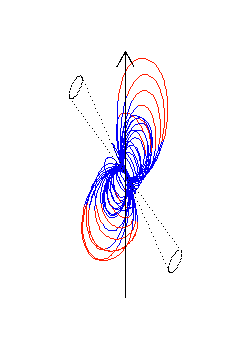
The HTRA 2001 workshop logo
Neutron stars are highly compact objects that rotate on the order of milliseconds to seconds. The light emission profile of one rotation period can vary on timescales of nano-seconds - as observed in radio waves. To obtain detailed light curve data of these objects requires high speed detectors together with a fast timing data collection system and image post-processing techniques.
The animation on the left shows magnetic field lines surrounding a rotating neutron star. This structure constrains the plasma motion of particles which are responsible for the non-thermal neutron star emission. The magnetic field structure modelled here is that of a retarded dipole due to the relativistic motion of the field as the star rotates. The magnetic axis of the star is oriented at 45 degrees to the rotational axis (shown as the vertical arrow).
For illustrative purposes the 'cone' of emission seen to emanate from both poles represents the most likely sourse of radio emission. The red field lines show the 'outer gap' regions from where a competing theory of pulsar gamma ray emission argues is the location of the high energy emission region. It is not known at present where the IR -> UV emission occurs within these objects - the animations presented here are part of the ongoing research in the Astrophysics & Scientific Computing Group to model where the radiation may arise.
For practical considerations this model rotates at roughly half a revolution per second. In reality the Crab pulsar spins at ~ 60 times this rate ( ~ 0.034s) i.e. if this simulation were to be placed at the surface of the Crab neutron star at its equator, it would have travelled a total of ~1.9 million km's in the last second!